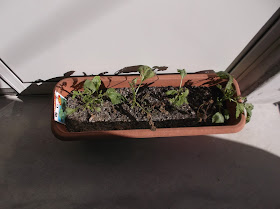In Yamagata prefecture, this dish is simply called dashi. It has nothing to do with dashi (broth). My family keep receiving summer vegetables from my father, relatives, and acquaintances. Today, my wife said she wanted to have (Yamagata's) dashi.
山形県では、この料理は単に「だし」と呼ばれています。出汁とは何の関係もありません。我が家では、父、親戚、知り合いから夏野菜をもらっています。今日は、妻が(山形の)だしを食べたいと言いました。
I did some googling and found that cucumbers, eggplants, myoga, and ao jiso (green perilla) are common ingredients.
ちょっとググると、きゅうり、なす、みょうが(茗荷、ミョウガ)、青紫蘇(あおじそ)が一般的な具材だと分かりました。
The other day, I got these tiny myoga from my father.
先日、父からこの小さな茗荷をもらいました。
The ao jiso in the planter boxes had already wilted,
プランターの青紫蘇はもう萎れていますが、
luckily, I have some ao jiso plants, which have grown just by themselves.
運よく、勝手に生えてきた青紫蘇が少しあります。
The recipe is:
Just finely chop each ingredient (5-mm cubes) and mix together. As for eggplants, finely chop them first, soak in cold water for a few minutes, and squeeze before mixing. Add some soy sauce.
Common ingredients for 1 serving:
1 cucumber
1 small eggplant
2 myoga
5 ao jiso
60 ml mentsuyu (noodle soup) concentrate
レシピは、
具材をそれぞれ(5mmの四角に)細かく切り、合わせます。なすに関しては、まず細かく切り、冷水に数分漬けてから、絞って、合わせます。しょう油を入れます。
一人分の一般的な具材:
きゅうり 1本
小さいなす 1本
みょうが 2本
青紫蘇 5枚
麺つゆ 60 ml
Let sit in the fridge for a few hours or overnight.
Great as a topping for hot rice and somen (thin noodles).
数時間または一晩、冷蔵庫に入れます。
温かいご飯や素麺に載せると美味しいです。
I also made nasu miso (eggplants pan-fried with miso, mirin, and sugar). This time, I added ginger and green peppers.
なす味噌も作りました。今回は、しょうがとピーマンを入れました。
I also made saba no miso ni (mackerel simmered with miso, sake, and mirin).
サバの味噌煮も作りました。
I boiled somen in a usual way,
素麺(そうめん)を普通に茹で、
I also boiled some other somen in water plus baking soda to make the somen taste like ramen noodles.
湯と重曹で別に素麺を茹でて、ラーメンの麺のようにしました。










"Ao jiso growing on its own"??? Why? Why shiso doesn't like me? Anyway, the dish is very interesting and perfect for the summer. I also like nasu miso. Pity I have just made some baba ghanouj (a paste made of grilled aubergine flesh mixed with sesame paste), I would have made nasu miso... Next time!
ReplyDeleteYour myoga made me dream of my next visit to Japan... This time I think I will bring lots of pickled myoga. It was fantastic!
I have eggplants in storage but no cucumber and my 3 myoga plants are kindly producing leaves but no buds as so far, so sadly I cannot try this dish out tomorrow (I really would go for it).
ReplyDeleteWhen do myoga plants start to produce buds I wonder...
I still have one big shiso plant left producing lots of big leaves and my husband knows it quite well because he had to water it everday (sometimes twice) during my journey and therfore he complained about this very thirsty thing (laugh).
I found a nice post about dashi:
ReplyDeletehttp://www.japanfarmersmarkets.com/2009/09/dashi-seven-vegetable-relish.html
Sissi: I wasn't lucky with the shiso in the plater boxes; after initial harvests, they started to be eaten by worms.
I'm really glad that I carefully left those shiso plants when weeding the yard around my house. They are thriving despite intense summer heat.
Kiki: When I called my father to thank him, he said that his myoga had just started to produce buds. That's why the myogo are very small.
You can use other summer vegetables like okra and carrot and small amounts of aromatic vegetables like negi and ginger.
Dashi was just a local dish of Yamagata prefecture, and it's since Daniel Kahl
http://en.wikipedia.org/wiki/Daniel_Kahl
introduced it in a TV show that it has become known throughout Japan.
Daniel's version used soy sauce (if I remember correctly), but the recipes I found yesterday all called for store-bought mentsuyu concentrate.
It was very nice of your father to sent you the first myoga of the year. My mom sent me 6 bottles of home made elderflower cordial. This sirup tastes nice and refresing just mixed with sparkling water. Parents are something...
ReplyDelete